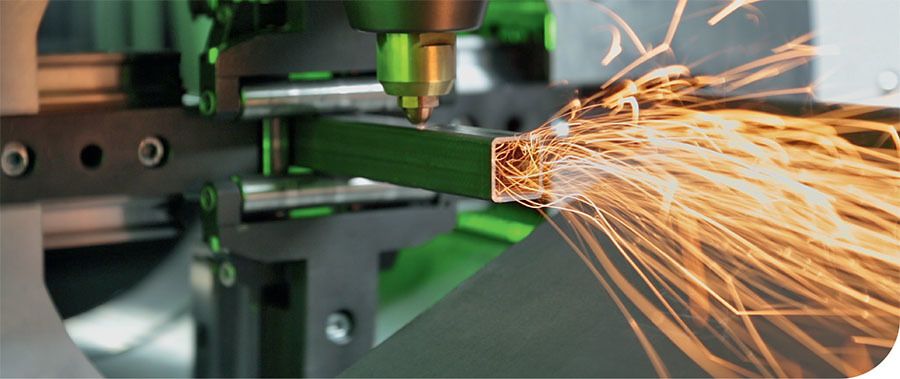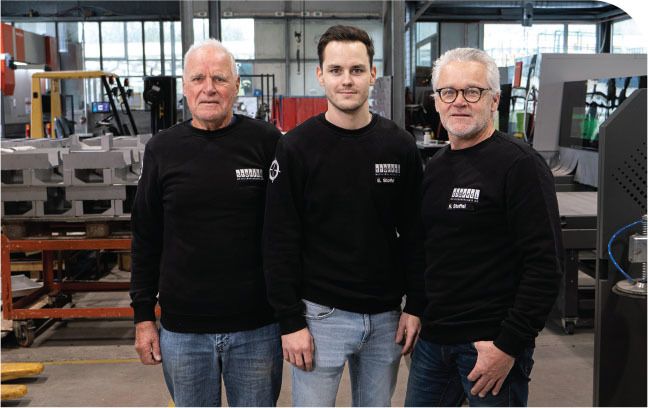
News One job launches new world of laser tube cutting possibilities
For Stoffel Metallbautechnik in tiny Raron, Switzerland, what may have looked like a snap decision to purchase a new tube laser in late 2023 was actually the culmination of a long process, catalyzed by a single project.
Managing Director Elia Stoffel, the third-generation head of his family’s 15-employee shop in southwest Switzerland, had contemplated purchasing a tube laser before he heard about a new adventure trail being planned in Zug, Switzerland, where the company has a second location.
Stoffel inquired about it and learned that the trail would include a 350-m walking bridge made by cutting to length, cutting holes in, painting, and galvanizing long sections of mild steel tubing 50- by 50-mm square. And because Stoffel happened to get involved with the project early on, he was given the opportunity to help plan the details of the metalwork with the designer, drawing directly from the client’s 3D model.
One Project Leads to the Future
The company has been fabricating steel tubing for years, so Stoffel knew he and his team could handle the adventure trail. In fact, the job wasn’t even the biggest one they had done. The issue was the timing: This was December. The park was scheduled to open the following summer. But with the equipment the small company had on hand, the schedule was simply too tight.
That’s when the process of purchasing the company’s first Bystronic By-Tube Star 130 kicked into full gear. Knowing that internal buy-in for purchasing new technology is not automatic, Stoffel alerted his team and told them the stakes.
"We had to fulfill a job that we were not able to fill without the machine," Stoffel recalled in his typical matter-of-fact way. "It was huge. There was a very harsh deadline. We said, ‘It’s not possible to fulfill the job with the machinery that we have already.’ Therefore, the process was, ‘Guys, we have to have a machine with which we’re able to fulfill this and to bring us a step ahead of a lot of other metal construction businesses.’
"We’ve had much bigger jobs than this one, but this one was very particularly made for buying a tube laser," he said. "I already had it in mind two or three years ago that maybe a tube laser could be very, very good for us because I see this as an investment in the future also."
When the laser was delivered in February 2024, the company had all the tubing waiting to be fabricated. As soon as the machine was installed and ready to cut, it was all hands on deck.
First, the tubes had to be cut, then colored and galvanized. And it all had to be done in time to ship and install before the adventure trail’s June grand opening.
"The machine came in and we just cut it all in like two or three weeks," Stoffel remembered. "Then in three months, we went to installation. It was a lot of work. Even my granddad came and helped out. It was very nice, but we had some tough moments."
Features for Speed and Quality
Those tough moments were made a bit easier by features that improved both cutting speed and quality over the cutting methods the shop was using before.
The first is a Quick Cut feature that can operate in two different modes, said Gabriele Rebessi, national product, application, and training manager for Bystronic. In performance mode, the goal is speed. The machine moves the cutting head in one direction and the workpiece the opposite way, reducing the time needed for each cut. In quality mode, the machine helps minimize material vibration and movement by moving the cutting head only. This helps reduce mistakes and scrap and, as a result, total delivery time to customers.
"You move the head on top of the material, and in this way, you reduce possible material flexions and deformation during its movement when it’s pushed and pulled by the chuck," Rebessi said. "In this way, you can improve and guarantee the high quality of your cutting feature. If a hole needs to be rounded or if the corner of a square hole needs to be perfectly 90 degrees, that’s the only efficient way to guarantee it."
Of course, cutting fast is far from the only consideration for getting finished parts out the door quickly. Another is quality control, for which Bystronic has included a Laserscan feature that identifies anomalies in the profile of raw materials. It’s one more way to help customers mitigate the inevitable unforeseen circumstance.
"Every material, depending on different temperatures, can have a deformation," Rebessi said. "Mild steel, especially, is very subject to deformation because of temperature. This is not as frequent on the aluminum and stainless steel, but it still is something that can happen.
"What the laser scan does is compensate for the tube bending and twisting, not only for close profiles such as round and square, but also for iron angles and channels."
The laser can process round, square, rectangular, and oval tubes from 3/8 to 5 in. dia. up to 28 ft. long and weighing up to 11 lbs./ft. It also can handle channels of various shapes with the same specifications.
Stoffel marveled at the boost in productivity the tube laser gave his shop. "It’s crazy fast," Stoffel said. "You are much quicker in production time. You can cut whatever you want into the tubes, and the quality is much better. It’s very nice. And I also think that our output went much higher. "The only problem we have here in our shop is the space—we never have space, ever," Stoffel said. "For this job, it was essential that we could load the machine with 21 ft. and unload 20 ft. Normally you have 6.5 ft. or 13.12 ft. of unloading, but not 20. This was a crucial point.
"For us, it was very handy that we have the bundle loader behind the machine. We can put 4.5 tons of steel or whatever material on it, and then it separates it to single pieces. That’s perfect."
Ushering in the New
This latest acquisition is just the latest in a long line of big technology investments the company has made.
Stoffel’s grandfather, René, started the company in 1976 and then in 1990 passed it to Stoffel’s father, Rolf, who made most of the modern capital equipment purchases that set the company on its current course.
Now it is Stoffel’s turn to continue the legacy, and the 27-year-old mechanical engineer is running the business full steam ahead with whatever technology can help it stay ahead of the competition and customer demands. Any new technology motivates Stoffel, but it was his grandfather’s reaction to the tube laser that really excited him.
"He sawed everything by hand, he drilled everything by hand, he welded everything by hand," Stoffel said. "When we brought the machine in, he came to the shop. And then when we cut the first tube, he did not understand what happened. He said, ‘Why didn’t we buy this before?’
"Even now, after one year, he comes in and watches how the machine works," Stoffel added with a big smile. "He says, ‘That’s not possible—how can this be possible?’ It was already like this with the flat laser, but now, with the tube piece, he completely lost his mind."
However, as impressive this latest machine has been, not everyone was as excited as René to put it into production. Stoffel said that is understandable, given how much the new machine has disrupted the old way of doing things.
"You have to change all the construction design processes," Stoffel said. "They now need to draw everything with tubes. It’s not only buying the machine, putting it in the shop, and saying, ‘OK, let’s go.’ There is a lot of thinking behind this. I would say it’s like a new car. You need to get adapted to it. There’s a lot of people that don’t want to adapt—not only the designers, but also the people in the shop.
"Some people say, ‘We never did it like this—we don’t want to change.’ I hate that sentence," he said. "I just don’t tell it to them because we want to go further and explore stuff. We have good designers who also want to explore. And we also have communication between the guys in the shop and also upstairs in the office. In the evening, we order a pizza, everyone is at the table, and we discuss this. That’s a nice moment."
Automation and the Labor Battle
As with fabricators worldwide, Stoffel must fight to keep even his small shop staffed adequately. On top of the normal squeeze on skilled people in a town of 2,000 residents, Stoffel plays David to a nearby Goliath—Lonza Bioscience, a worldwide leader in healthcare manufacturing that employs 4,500 people at a sprawling facility just 5 miles away in Visp, Switzerland.
Having automated technology helps Stoffel stay productive, but he still has to have people who can run the machinery. That remains a regular challenge.
"We are very happy with the team that we have," Stoffel said. "We have the best employees, I would say. You can buy the best machines you want. If you have no one to use them, that’s not good."
Because that team is small and despite its floor space limitations, for the past 35 years, the company has continuously invested in machinery to stay ahead of both the technology curve and its competition. That capital inventory includes a combination punch-laser machine ("a very big investment," Stoffel said), press brakes, a waterjet cutting table, a robotic welding machine, and an automatic sheet metal storage system.
The investment has proven profitable for a family business that, though it operates in a relatively small cluster of communities, still deals with significant local competition.
"There [are] a lot of small companies," Stoffel said. "I would not say that we are a big one—we are 15 people. That’s fine. We just have a lot of machines. Maybe that’s why we have less people than others do. There’s a lot of competition around here, but with our machinery, we are able to be more competitive."
And, of course, there’s only so much work to go around. So, years ago, the company opened the Zug operation, about three hours away by car, to mitigate the ebb and flow of business in the valleys around Raron. It’s one way to keep work local but also spread out.
"If there’s a lot of competition in the market in the valleys right now because there’s not a lot of work, maybe in the other market there is less competition," Stoffel said. "At the moment, we have about 50% of our work in Zug and 50% here. If there’s more work [there], we go there. If there’s more work here, we stay here. We have a more flexible way to find what we want to do."
As seen in the cover story of Tube & Pipe Journal - June 2025
By Lincoln Brunner

